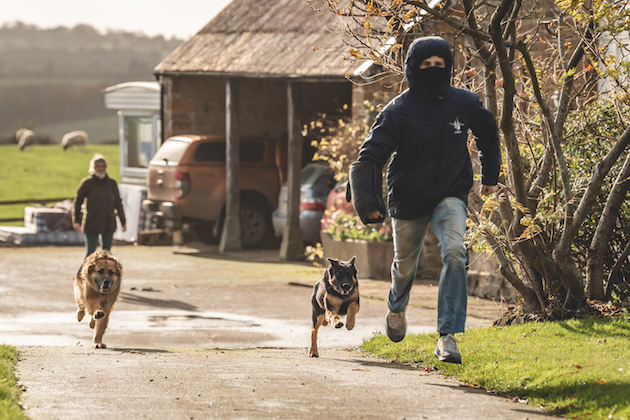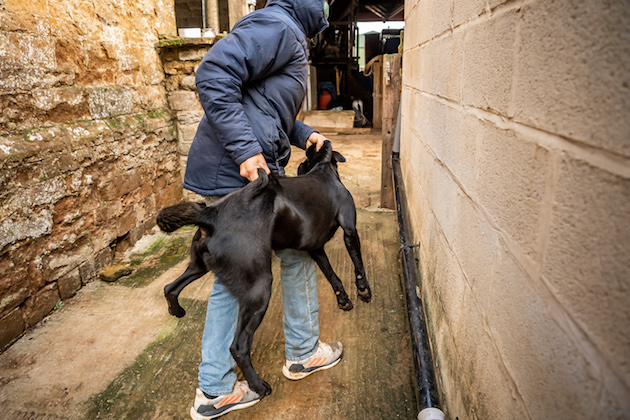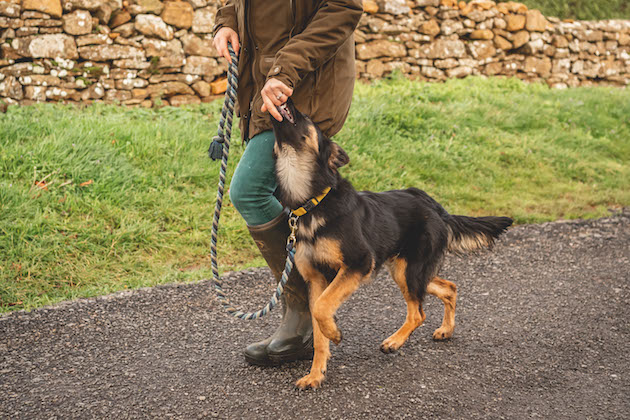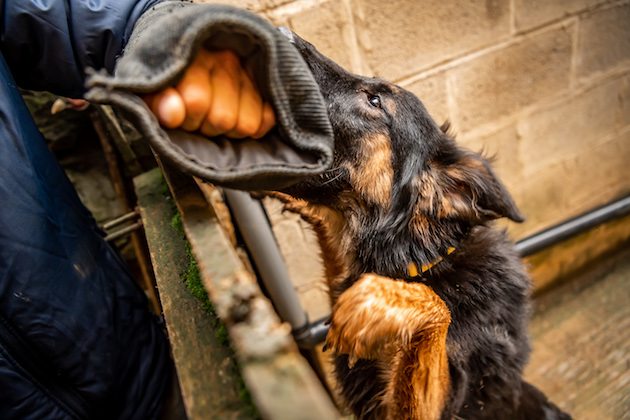Win CENS ProFlex DX5 earplugs worth £1,149 – enter here
Guard dogs to guard gundogs
 Tilda: 7) German Shepherd dog chasing thief
Tilda: 7) German Shepherd dog chasing thief
Dog theft is a hot topic at the moment; in particular of gundogs. They are stolen from cars, kennels, houses and gardens. One of the issues is the money these dogs are worth to potential thieves. Another big issue is that the breeds most commonly used as gundogs are inherently gentle and kind-tempered. This makes them easy to grab. Spaniels, due to their size, are very easy to grab and chuck into the back of a car.
There are many things that can be done to keep your dogs more secure, such as using padlocks that cannot be cut off with a bolt cutter. If the dogs are kept indoors, lockable windows are a must, as is keeping the dogs out of sight. The same goes for kennels. Ideally you should not be able to see anything by simply looking through a window.
Security cameras are a great idea and it is worth investing in a system that shows clear pictures in all weathers and light conditions. Motion detectors on cameras are really useful, though they can be a little frustrating if a songbird keeps setting them off. Security lights provide an added layer of protection because they alert anyone near to someone’s presence. Finally, alarmed doors and/or windows are excellent. Anything that is noisy and bright will ensure an intrusion is announced.

Gundogs are targeted by thieves partly due to their gentle nature, as well as their high value
Deterrent
However, many thieves do not worry if you have a camera as a balaclava soon sorts that. A lot of people will ignore an alarm going off locally so, again, it’s not always a great deterrent. So many, like me, turn towards a guard dog. It is well known that burglars hate dogs. Co-Op Insurance conducted a survey on ex-burglars and listed the things they hated or avoided the most. At the top of their list was noisy dogs. Dogs can be extremely persistent with their barking and very difficult to quieten.
If you are choosing a dog specifically as a guard dog, then breed is very important. I have grown up with German shepherds (GSD) my whole life. My first girl potentially saved my life when I accidentally caught an intruder attempting to break into our barn. He chased me towards the house, at which point I let my GSD out. She chased him to his car, which was waiting with a driver on the road.
No amount of cameras, alarms or lights could have protected me like she did. A GSD is big, powerful and has a natural loyal desire to guard their family. They will not have to be taught how to guard as the vast majority do it naturally. They are very good as family dogs and, though big, tend to be very good with children.
Belgian Malinois have grown massively in popularity recently and are similar in shape and size to a GSD, but are much more intense. They are a true working dog. They make fantastic guard dogs and have earned the nickname ‘maligator’. However, it is vital that a high-energy dog like this has a specific job. They will not be content to simply walk around a yard guarding on their own.
Powerful
The Rottweiler is another popular breed. They are big powerful dogs and tend to have very soft natures unless they or their family unit is threatened. Again, guarding is not something they will usually require to be taught. The Doberman, giant schnauzer, Dutch herder, akita and bull mastiff can all make extremely good guard dogs, as well as lovely family pets. However, there is a growing trend to one or two particular breeds.
The Caucasian shepherd dog and central Asian shepherd dog are truly huge animals. Designed to protect livestock against wolves, bears and even lions, they are among only a handful of breeds that can take down a wolf one-on-one. They are very loyal, caring and loving to their own family, but due to their size and strength they are only for the experienced handler with the right kind of home to guard, such as smallholdings or farms. Care must always be taken.
All these breeds are similar to a gundog when it comes to training, in that they all have an instinct to work/guard but teaching them to obey basic commands is absolutely vital. Guard dogs will guard naturally but that instinct must be harnessed and controlled. Many make the mistake of assuming that because the dog barks/guards naturally they are trained. Like most, I have children and visitors often coming to my home. I need to know that when I am there I have control of my guard dogs.

A vital part of the guard dog’s training is that it is always under your control
An ‘off switch’ is, again, vital. I start all my guard dogs in a very similar way to any other puppy. I look to teach the basics. Guarding breeds tend to be very powerful and I need to be able to walk them without being pulled over.
When people arrive, it is important that I can keep my guard dog away from the front door or gate. I have known of people being bitten by dogs at a front door as the owner cannot restrain the dog and open the door at the same time. Instead of fighting the dog, a solid sit is a good skill to teach. Accidents do happen, doors or gates get left open, innocent people may walk where they aren’t meant to, so a solid recall can be a lifesaver.
Aggressive
One of the common mistakes people make with a guarding breed is to assume an aggressive dog is a good guard dog. This couldn’t be further from the truth. A good guard dog should be calm, controlled and content in most situations. In order to do their job well, they must be extremely confident. Confidence does not mean randomly wanting to attack or bite everything and everyone. That kind of dog is unpredictable and more often than not totally uncontrollable.
To prevent this the dog must be socialised and trained correctly as a youngster. It must meet and see as much as possible and be trained to simply ignore it. Mine are all trained around children, in towns, public areas and so on so nothing fazes them. They hear gunshots, learn to swim, jump and are trained around livestock and cats.
This means as they get older that there is very little that worries, scares or distracts them when it comes to doing their job. A lot of the time when a guard dog is needed, the owner will not be present so they need every belief in themselves.

Training a guard dog – with a protective sleeve – at point of entry protecting a property
Bark on demand
I am currently training my next guard dog, a German shepherd-Belgian Malinois bitch, and at eight months old she is learning her trade. She has been well socialised already. She is learning heel and a solid ‘down stay’ which means I can walk away from her and she won’t move until either I call her or someone runs towards her. One of the things she is learning at the moment is to bark and be quiet on demand.
Fortunately I have an older GSD for her to learn from. Like gundogs, having an older dog for them to follow and learn from is very helpful. My older GSD will bark on command and guard when told. If you have only one dog, it is easy to encourage that dog to bark by knocking on a door or winding them up with a toy. Then simply add a command so they make the association of barking to that command.
There are many good trainers who can support an owner wishing to get a guarding breed. For those who are not experienced with this sort of dog, it is essential they go to a specialist. They can guide you on how to get the perfect balance of family pet and guard dog.
Related Articles
Get the latest news delivered direct to your door
Subscribe to Shooting Times & Country
Discover the ultimate companion for field sports enthusiasts with Shooting Times & Country Magazine, the UK’s leading weekly publication that has been at the forefront of shooting culture since 1882. Subscribers gain access to expert tips, comprehensive gear reviews, seasonal advice and a vibrant community of like-minded shooters.
Save on shop price when you subscribe with weekly issues featuring in-depth articles on gundog training, exclusive member offers and access to the digital back issue library. A Shooting Times & Country subscription is more than a magazine, don’t just read about the countryside; immerse yourself in its most authoritative and engaging publication.







